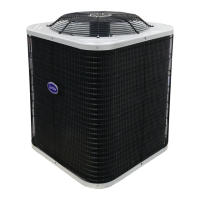A
CCESS
ORY
OUTDOOR UNIT
A
B
O
V
E OUTDOOR UNIT BEL
O
W NO ELEVATION
CHAN
GE
AC
HP
AC
HP
AC
HP
Liquid l
ine
solenoid
(LLS)
at ou
tdoor
No
Ye
s
KHALS0401LLS
No
Ye
s
KHALS0401LLS
No
Ye
s
KHALS0401LLS
TXV on indoor
(S
tandard
on all 13 SEER
platfo
rm
indoor coils
and fan
co
il
s)
Ye
s
Ye
s
Ye
s
Ye
s
Ye
s
Ye
s
Crankcase h
eater
(if not factory su
pplie
d)
Ye
s
Ye
s
Ye
s
Ye
s
Ye
s
Ye
s
Start capacitor and r
elay
Ye
s
Ye
s
Ye
s
Ye
s
Ye
s
Ye
s
Heating piston
change
N/A
see
Yes
12
N/A
Ye
s
see Table 9
N/A
No
Inverted tr
ap
N/A
N/A
Ye
s
See Fig. 3
Ye
s
See Fig. 3
N/A
N/A
Table 1 – Long Line Accessory Requirements
T
able
!
CAUTION
COMPONENT FAILURE HAZARD
Failure to follow this caution may result in unit component failure.
For proper oil return and minimizing capacity losses, only use vapor line sizes listed in Tables 3.
E. Interconnecting Tubing and Fitting Losses
Choosing the proper tubing diameters is critical for reliable long line applications. For proper suction line sizing, see Table 3 the chart
shows all acceptable suction line diameters and related performance data based on total equivalent length. See Tables 5, 7, and 10 for
the allowable liquid tubing diameters for single- stage.
Refrigerant tubing must be measured both in terms of actual length and equivalent length. Use actual length for limitations and
refrigerant charge calculation. The maximum liquid line length will vary depending on diameter and elevation change between indoor
and outdoor units. Equivalent length takes into account pressure losses from both tubing length and losses due to fittings and
accessories, such as elbows, liquid line solenoid and filter drier. Losses from fittings are expressed in equivalent length, meaning the
length of straight tubing that would have the same pressure loss as the fitting. See Table 2 for equivalent lengths of commonly used
fittings and accessories; maximum equivalent length allowed is up to See Table 5, 7 , and 10for maximum total equivalent length.
Calculate
total equivalent length by adding linear (actual) length of the tubing required and the equivalent length of all elbows and
accessories used. See Tables 3 to determine capacity loss of the system due to equivalent length losses and subtract them from the
published system capacity for the particular outdoor/indoor unit combination. This data is found in the outdoor unit Product Data.
Example: A 4- ton system using 7/8 in. diameter line set has a total tubing length of 165 ft. The tubing configuration uses four standard
90° elbows and two 90° long- radius elbows. Checking Table 2, the total equivalent length is calculated as:
165 ft straight tubing + (four standard 90° elbows x 2 ft) + (two long- radius 90° elbows x 1.4 ft) = 165 ft. + 8 ft + 2.8 ft = 175.8 ft total
equivalent length.
A
B
C
90° STD
90° LONG RAD
Fig. 1 – Tube Bend Losses
Table 2 – Fitting Losses in Equivalent Feet
45° STD
A01058
Tube Size O.D.
(I
n
.
)
Fitting --- Reference Diagram in Fig.
1
°
°
°
1.2 0.8 0.6
1.8 1.2 0.9
2.6 1.7 1.3

